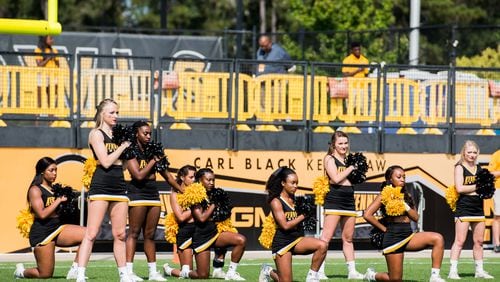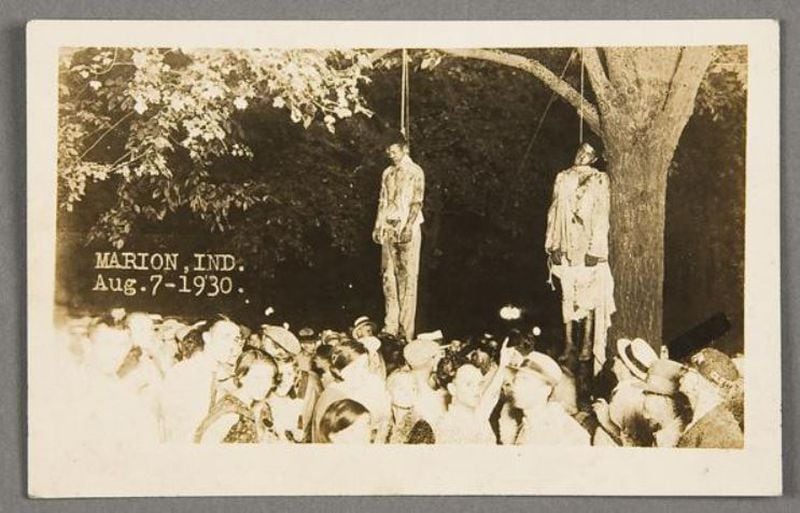A Duke and University of North Carolina graduate, David Parker is a professor of history at Kennesaw State University and has been the department’s assistant chair since August 2009. Parker teaches classes in Georgia history, the history of American religion, the Gilded Age, and research methods.
In this piece, Parker discusses the controversy at Kennesaw State University over the five cheerleaders who took a knee on the football field during the national anthem, putting their actions in the context of African-American history in America and Georgia.
Be forewarned, the piece references lynching, including the practice of turning news photos of lynchings into postcards. One such postcard is shown.
Dr. Parker wants it known these are his views and not those of Kennesaw State. I want it known this is one of the most powerful columns I have ever had the honor to share on the AJC Get Schooled blog.
By David B. Parker
A few weeks ago, just before a football game against the visiting Crusaders from North Greenville University, five Kennesaw State University cheerleaders knelt during the playing of the National Anthem to protest police brutality against African-Americans. KSU officials promptly banned the cheerleaders from the football field at future games until after the anthem had been played.
Yesterday, in a letter to the KSU community, President Sam Olens announced, “I have decided that at Kennesaw State university’s next home game on November 11, the pre-game program will be restored to its original format, with the cheerleaders taking the field before the singing of the National Anthem.”
He could have stopped there, but he didn’t. “I will stand during the National Anthem,” he continued, “to honor the women and men who have served in our nation’s armed forces. While I choose this action, I do not believe that this debate has to be a choice between honoring our veterans and protecting the freedom of speech. We must be able to do both.”
For one of my classes a couple of days ago, I had students read The Atlanta Constitution’s coverage of the lynching of Sam Hose. Hose was an African-American accused of murdering Alfred Cranford, a white man, and raping Mattie Cranford, his wife. Sam Hose was lynched in a field in Newnan, Georgia, on the afternoon of Sunday, April 23, 1899.
Credit: Maureen Downey
Credit: Maureen Downey
The Constitution covered the event in great detail. “The spot selected was an ideal one for such an affair,” the paper said, “and the stake was in full view of those who stood about and with unfeigning satisfaction saw the negro meet his death and tortured before the flames killed him.” The Constitution estimated the crowd at 2,000 many of whom rode from points north on special train cars set up to handle those from Atlanta who wanted to be there.
“Before the fire was lighted his left ear was severed from his body. Then the right ear was cut away…. Other portions of his body were mutilated by the knives of those who gathered about him, but he was not wounded to such an extent that he was not fully conscious and could not feel the excruciating pain.” We talked in class about how lynchings often had a ritualistic aspect, including such mutilations. The Constitution does not say so, but we know from other accounts that the “other portions of his body” included his genitalia.
And then they lit the fire. Only then, the paper says, did Hose scream.
Through it all, the Constitution reported, the crowd was “orderly and well-behaved,” at least until the fire had died down. Then there was a mad rush to claim every bit of bone and flesh that had survived the flames.
I talked with my students about another lynching, three decades later, in Marion, Indiana, at which two black men were hanged. A picture on the front page of the local newspaper the next day showed the dozens of people who came to revel in the aftermath, including a couple—they look like they’re on a date—looking into the camera, holding hands and smiling.
That led to a discussion of "Without Sanctuary," the website and book of lynching photographs and postcards —postcards! — collected by Atlanta art dealer James Allen. When we go on vacation, we buy postcards with pictures of local attractions on the front, write "Having a great time, wish you were here" on the back, and send them to friends back home. One of the postcards Allen found shows the suspended body of a black man, surrounded by white spectators, from a 1910 lynching in Texas. The inscription: "All OK and would like to get a post from you, Bill. This was some Raw Bunch."
Credit: Maureen Downey
Credit: Maureen Downey
We talked about the number of lynchings over the years—well over 4,000 between 1880 and 1930, almost all in the South, almost all black men. We looked at a list of the 460 lynched in Georgia. All but 19 were African-American.
When I read Sam Olens’s letter yesterday afternoon, I thought again of James Allen. Several years ago, Allen tried to arrange an exhibition of his lynching photographs. No one in Georgia would touch it. The first two exhibitions were in New York, with a third in Pittsburgh. Michael Lomax, now president and CEO of the United Negro College Fund but at the time an English professor in Atlanta, said, “This shows how reluctant Atlanta is to confront something other than a chamber of commerce, sanitized version of its history.” Rick Beard, then director of the Atlanta History Center, put it more bluntly: “The ‘city too busy to hate’ is often also the city too busy to think deeply about the painful aspects of its past.”
Olens’s letter reminded me of the importance of the Black Lives Matter movement, because historically, in Georgia and elsewhere, black lives have emphatically not mattered.
I regret President Olens’s implications that “taking a knee” during the playing of the National Anthem is a sign of disrespect to our veterans and that the cheerleaders’ actions were a context-less exercise of free speech. I wish he could understand that the cheerleaders were not just taking a knee on a football field; they were kneeling in the stream of history, a history that we cannot forget.
About the Author









